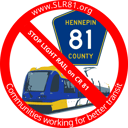Fact Sheet: The Big 15
Blue Line Extension, Light Rail, and the Met Council
Sources Verified & Updated:
3/19/23
1. The original alignment (route) was planned for the BNSF rail corridor, rather than CR 81, including West Broadway & Bottineau Aves. This would have eliminated many current concerns regarding traffic disruption, pedestrian safety, vehicle and emergency vehicle safety, construction of unsightly parking ramps in the commercial corridor, destruction of good quality road and infrastructure, displacement of northside residents/businesses, and so forth.
2. MetCouncil ridership data is based on Pre-Covid transit data. “A recent survey from the US Census Bureau, first reported by Axios Twin Cities, found that 26% of Twin Cities workers reported are now working from home.” (KARE 11) Based on national averages, this is over four times greater than pre-pandemic figures. (Census.Gov)
3. West Broadway Business & Area Coalition is opposing the current alignment due to unaddressed concerns about residential and commercial displacement.
4. From 2010 to 2017, multifamily buildings in Saint Paul within a half mile radius of the Green Line had rent increases 20% higher than elsewhere citywide. (MHP) Since 2010, nine properties have been built in Saint Paul within a half-mile radius of the Green Line; seven of those properties have average rents of $1,712 per month, far above the current citywide average of $1,075. In these buildings, rent has increased 24% since 2010. Hence the need for rent control laws that recently went into effect.
5. The Southwest Light Rail (Green) line is now expected to cost $2.76 billion, with a $760 million deficit. It is nine years behind schedule. Newly projected costs determined by the Minnesota Auditor of the Legislative Office are over twice the original estimates derived in 2011.
6. The Minnesota Auditor of the Legislative Office determined that the MetCouncil failed to provide full transparency related to costs for the SouthWest light rail corridor, did not hold contractors accountable, and failed to recognize adverse soil conditions that have plagued construction. (KSTP)
7. Calculations by engineering experts have determined that average velocity of the Blue Line train will be between 14 and 17 mph. This is significantly slower than comparible/modern light rail services in other major metro areas which average over 20 mph. Travel between the northernmost stop in Brooklyn Park to Target Center will take approximately one hour in length. The Met Council still has not released projected time tables for Blue Line Extension passengers. (J.Johnson, 2023)
8. Metro Transit reported a 54% increase in crime reports in 2022 (CCX Media, http://bitly.ws/BLXs) Drug complaints increased by 182%, weapons complaints by 145%, and liquor violations by 92%.
9. In 2015, fare evasion due to lax enforcement on Light Rail transit was estimated to cost Metro Transit at least two million dollars annually (based on current dollar values). Fare evasion losses, as a percent of total ridership, continue to increase.
10. In 2022, 49 citations were given to riders who were evading fare. This is 0.0012% of all riders. (StarTribune, http://bitly.ws/BMgI). However, conservative estimates say over 11% of riders are likely evading fare - or approximately 4,300,000 riders in 2022.
11. National surveys report most people living more than ¼ mile away from public transit will choose to drive to their nearest station, given the availability of parking facilities. This is commonly referred to as the “First-mile/last-mile (FLM) Problem.” Light Rail does not solve FLM. Arterial Bus Rapid Transit resolves this issue at substantially lower cost, but has been dismissed by the MetCouncil. BRT is much cheaper than building rail lines. “Minneapolis’s $75 million D-Line was completed on time and under budget,” says Katie Roth, the director of arterial bus rapid transit at Metro Transit.
12. FLM automobile trips, supported by large parking facilities in connection with Light Rail transit, may increase fossil fuel emissions significantly, mitigating potential impact reductions from light rail usage. In some cases, multimodal (car & rail) transit trips with first-last mile automobile use may have higher emissions than competing automobile trips. (Ariz. State Univ, http://bitly.ws/BMd4)
13. Northstar rail line runs between the town of Big Lake and downtown Minneapolis. Opened in 2009 at a cost of $317 million, the most recent ridership figures indicate approximately 307 riders per day. Cost for scrapping the Northstar line would require $85 million to be returned to the Federal DOT. It is one of the lowest performing commuter rail line routes in the country. (StreetsMN, http://bitly.ws/BMgi)
14. Excluding Chairperson Charlie Zelle, only two of the 16 members of the Governor-appointed MetCouncil have any substantive experience with large-scale transit project management. Despite intense public criticism due to management failures, Zelle was reappointed by Gov. Tim Walz on Jan 10, 2023.
15. From 2012 to 2013, State Safety Oversight Associations (SSOA’s) reported a 15.6% increase in pedestrian injuries resulting from light rail or streetcar train-to-person collisions for every 100M VRM (Vehicle Revenue Miles). (Dept of Transportation, http://bitly.ws/BMjZ)


